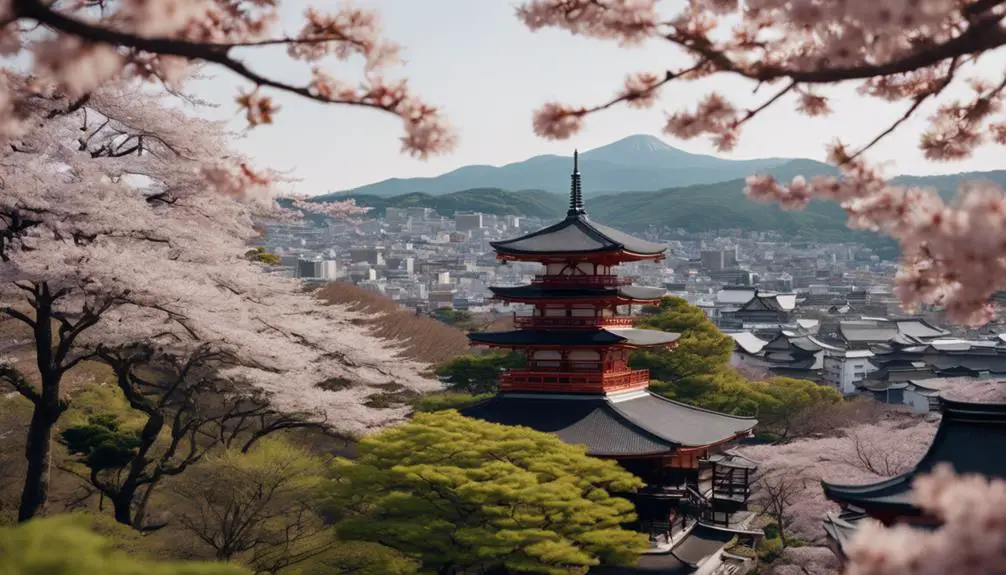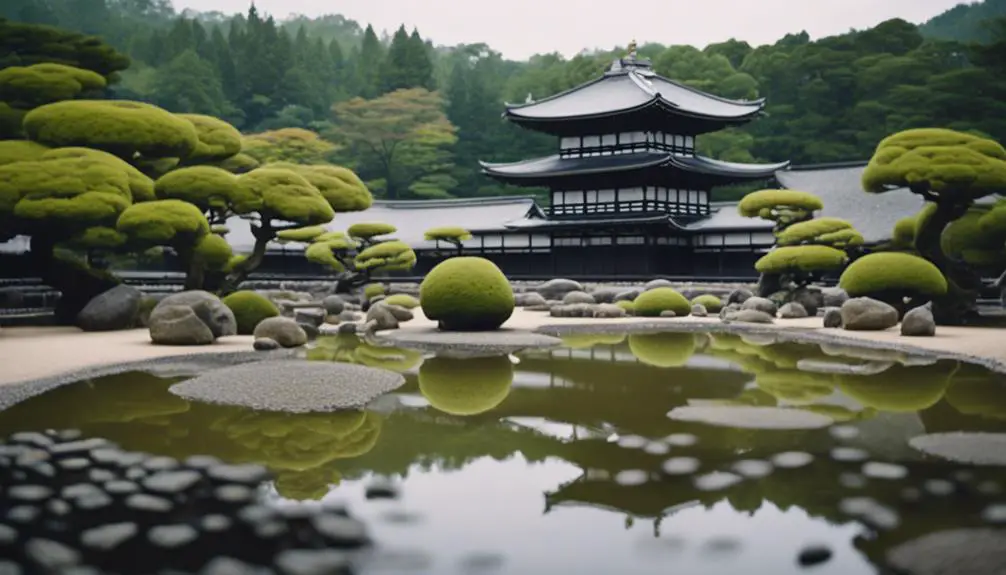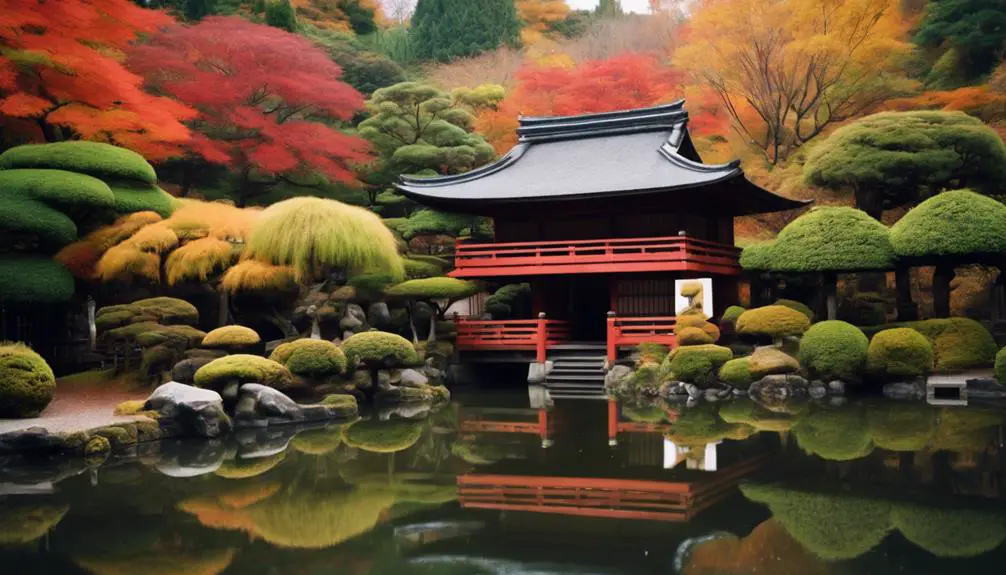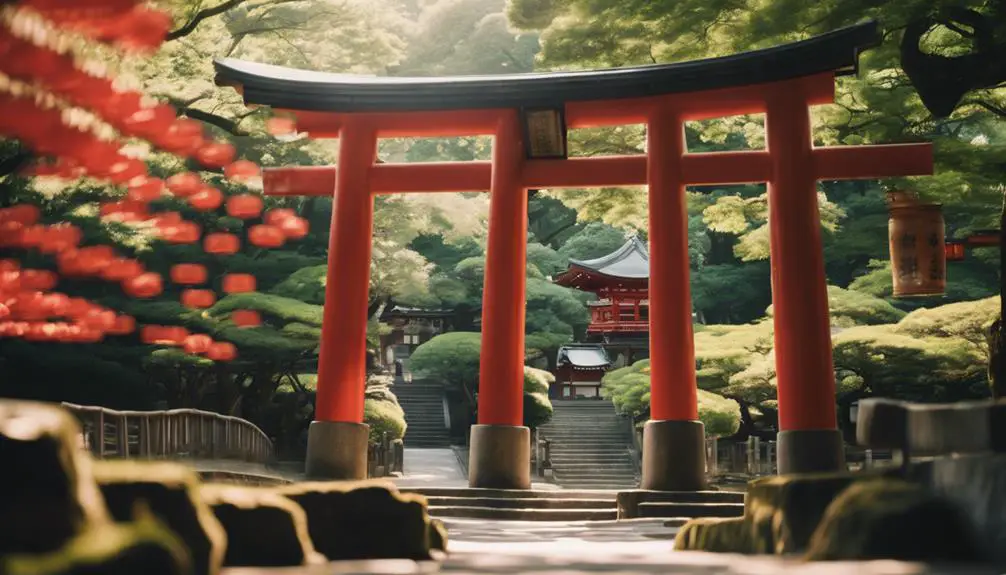7 Must-Visit Temples in Kyoto for a Serene Experience
When we think about finding tranquility amidst the vibrant energy of Kyoto, the city's temples immediately come to mind. Each one, from the gleaming Golden Pavilion of Kinkaku-ji to the serene rock garden of Ryoan-ji, offers a unique sanctuary for contemplation. But beyond their beauty, these temples reveal the deep cultural and historical layers of Kyoto. Ever wondered what makes Kiyomizu-dera's wooden stage so iconic, or why the vermilion torii gates of Fushimi Inari Shrine captivate every visitor? Let's explore the seven must-visit temples that promise a serene experience like no other.
Kinkaku-ji Temple
Nestled in the heart of Kyoto, Kinkaku-ji Temple, also known as the Golden Pavilion, captivates visitors with its stunning golden walls and serene surroundings. As a Zen Buddhist temple, Kinkaku-ji reflects the principles of Zen design, presenting an architectural marvel that combines elegance with spiritual depth.
The main hall, adorned in gold leaf, stands as the centerpiece of this UNESCO World Heritage Site, offering a magnificent sight that gleams brilliantly under the afternoon sunlight.
Wandering through the temple complex, we find ourselves immersed in a tranquil setting that invites contemplation and reflection. The meticulously maintained gardens around Kinkaku-ji add to the serene ambiance, with their artfully arranged plants, stones, and water features.
Each floor of the Golden Pavilion showcases a different architectural style, adding layers of historical and aesthetic value to our visit.
The shimmering golden exterior of Kinkaku-ji creates a striking contrast against the lush greenery and clear blue sky, making it a popular spot for photography enthusiasts. For those of us seeking cultural beauty, historical significance, and spiritual inspiration in Kyoto, Kinkaku-ji Temple is indisputably a must-visit destination that leaves a lasting impression.
Kiyomizu-dera Temple

While Kinkaku-ji dazzles with its golden splendor, Kiyomizu-dera Temple captivates us with its historic wooden stage and panoramic views of Kyoto. Founded in 778, this temple is an iconic symbol of the city's rich history and culture. The wooden stage, which juts out from the main hall, offers breathtaking vistas, especially during the cherry blossom and autumn foliage seasons.
The main hall, dedicated to Kannon, the Goddess of Mercy, adds a layer of spiritual significance to our visit. As we stand before the statue of Kannon, we can't help but feel a sense of tranquility and reverence. The Otowa Waterfall is another highlight; its waters are believed to bring health and longevity. Drinking from the waterfall is a ritual that connects us to centuries of tradition.
The approach to Kiyomizu-dera is lined with shops selling souvenirs and snacks, creating a vibrant atmosphere that contrasts beautifully with the serene temple grounds. As we explore, we notice how the seasonal changes enhance the temple's beauty, making each visit unique. In spring, cherry blossoms paint the landscape in delicate pinks, while autumn brings a fiery palette of reds and oranges. Kiyomizu-dera Temple truly offers an unforgettable experience.
Fushimi Inari Shrine

Fushimi Inari Shrine captivates us with its enchanting pathway lined with thousands of vermilion torii gates, creating a surreal and mesmerizing experience. As we walk through these iconic gates, we're enveloped in a vivid sea of red, leading us deeper into the heart of the shrine complex. This journey isn't just visually stunning; it's a profound spiritual experience, offering a serene escape from the bustling city.
| Aspect | Description | Experience |
|---|---|---|
| Torii Gates | Thousands of vermilion gates | Mesmerizing |
| Fox Statues | Symbolic messengers of Inari | Spiritual |
| Shrine Complex | Smaller shrines and tea houses | Enchanting |
| Hike | 2-3 hours to the summit and back | Immersive |
| Popular Destination | Tourists and locals alike | Vibrant |
The symbolic fox statues scattered throughout the shrine complex represent the messengers of Inari, the Shinto god of rice, adding an element of mystique to our visit. The shrine's serene environment, combined with the striking visual appeal of the vermilion torii gates, makes it a popular destination for both tourists and locals.
Embarking on a 2-3 hour hike to the summit and back, we can truly immerse ourselves in the serene surroundings, discovering smaller shrines and tea houses along the way. Fushimi Inari Shrine offers an unparalleled blend of natural beauty and spiritual depth, making it an unforgettable experience.
Ryoan-ji Temple

Ryoan-ji Temple enchants us with its world-renowned Zen rock garden, where 15 carefully placed rocks and white gravel create a mesmerizing scene of simplicity and harmony. This tranquil, minimalist garden, a UNESCO World Heritage Site, is a serene retreat from the city's bustle, inviting us to immerse ourselves in contemplation and focus.
Founded in 1450, Ryoan-ji Temple epitomizes Zen simplicity. As we stand before the rock garden, we notice a fascinating design element: no matter where we position ourselves, only 14 of the 15 rocks are visible at once. This clever arrangement encourages deep contemplation, aligning perfectly with Zen philosophy, which values the unseen and the unknown.
The garden's minimalist aesthetic is both calming and profound. The white gravel, meticulously raked into precise patterns, represents the fluidity of water, while the rocks symbolize islands or mountains. This timeless expression of Zen principles invites us to pause, reflect, and find inner peace amidst the simplicity.
Walking through Ryoan-ji Temple, we can't help but feel the harmony that permeates the space. It's a place where history, art, and philosophy converge, offering a unique opportunity to reconnect with ourselves and the world around us.
Chion-in Temple

Chion-in Temple, with its majestic Sanmon gate and centuries-old history, stands as a grand demonstration of Kyoto's rich Buddhist heritage. As we approach, the immense Sanmon Gate, one of Japan's largest wooden gates, immediately captures our attention. This iconic structure not only signifies the temple's grandeur but also offers a glimpse into its historical and architectural significance.
Inside Chion-in Temple, we find the national treasure painting of Ao Fudo. This powerful depiction of Fudo Myo-o, a guardian deity symbolizing protection and strength, adds a unique cultural layer to our visit.
- Historical Significance: Dating back to the 13th century, Chion-in Temple is a confirmation of Kyoto's enduring Buddhist traditions.
- Sanmon Gate: This intricate gate stands as a monumental entryway, inviting us into a world of spiritual reflection.
- Ao Fudo: The national treasure painting inside the temple symbolizes protection and strength, enriching our understanding of Buddhist iconography.
- Serene Atmosphere: The tranquil surroundings offer a perfect setting for contemplation and spiritual reflection.
- Cultural Immersion: Through its architecture and art, Chion-in Temple provides an in-depth exploration into Kyoto's cultural and religious significance.
Our visit to Chion-in Temple isn't just a journey through history, but also a moment of serene spiritual reflection amidst Kyoto's timeless beauty.
Hosen-in Temple

Stepping into Hosen-in Temple, we immediately sense the serenity and timeless beauty that define this thousand-year-old sanctuary. Nestled in Kyoto, Hosen-in Temple offers a peaceful escape, inviting us to leave behind the hustle and bustle of the city. This hidden gem stands as a testament to traditional Japanese architecture, featuring unique ceilings crafted from wood and a design that immerses us in tranquility.
The blissful garden of Hosen-in Temple is a highlight, especially the awe-inspiring 700-year-old Goyo-no-Matsu pine tree. As we stroll through the bamboo groves and moss-covered grounds, we feel an intimate connection with nature, making it an ideal place for contemplation and reflection. Every corner of the temple grounds beckons us to pause and appreciate the quiet beauty that surrounds us.
To help us plan our visit, here's a quick overview of what to expect:
| Feature | Description |
|---|---|
| Blissful Garden | Features a 700-year-old Goyo-no-Matsu pine tree |
| Traditional Architecture | Unique wooden ceilings and serene layout |
| Natural Surroundings | Bamboo groves and moss-covered grounds |
Hosen-in Temple truly embodies the serene, reflective experience that Kyoto's temples are renowned for, making it a must-visit destination for anyone seeking peace and beauty.
Kitano Tenmangu Shrine

Nestled in Kyoto, Kitano Tenmangu Shrine captivates us with its rich history and cultural significance, dedicated to the revered Japanese god of education, Sugawara no Michizane. As we step onto the shrine grounds, we feel the deep sense of historical significance and cultural importance that permeates this sacred space.
The shrine is particularly famous for its beautiful plum trees, with over 2,000 of them creating a stunning sight during the plum blossom season. Every year, visitors flock to admire the blossoms and experience the serene atmosphere that Kitano Tenmangu Shrine offers.
Here's what we can expect when visiting:
- Over 2,000 Plum Trees: These trees bloom magnificently, offering a picturesque landscape.
- Intricate Gate: The entrance gate is a marvel of traditional Japanese architecture.
- Serene Garden: The garden within the shrine grounds provides a peaceful retreat.
- Historical Significance: The shrine honors Sugawara no Michizane, enriching our visit with cultural depth.
- Ao Fudo Painting: This national treasure adds to the shrine's religious and artistic value.
Whether we're seeking tranquility, historical insight, or simply the beauty of nature, Kitano Tenmangu Shrine in Kyoto promises a serene and enriching experience.
